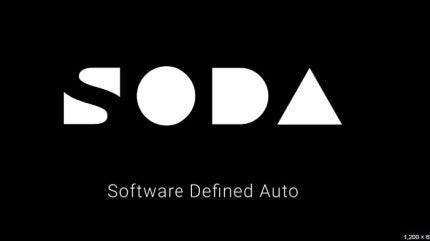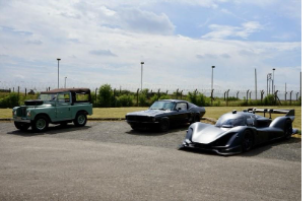
At a recent event hosted by UK-based start-up company SODA Auto, a company specialising in transforming the automotive industry by making vehicle software engineering a claimed 10x faster at 4x less cost, the company showcased their new ‘AI engine’ technology.
The new ‘AI engine’ can be found onboard a Charge Car’s 67 Mustang and adapts to the drivers’ preferences without the need for commands. For example, the technology can adjust the climate before the driver asks. By reading signals from the driver’s smart watch it prepares the cabin according to body state and heart rate.
SODA says that it is already extending the AI engine to other in-car functions including lighting, entertainment and driving styles.
Frankie Youd spoke to Sergey Malygin, CEO, SODA Auto during the event to discuss the current projects the company is working on and what the future holds for software defined vehicles (SDVs).

Just Auto (JA): Could you discuss what the company has achieved with the Charge Mustang?
Sergey Malygin (SM): We are unique in the way we control the drive motors. We use four individual motors, and we provide full traction control and torque vectoring so we can spin each wheel individually. On top of that, it’s also a bespoke interface in the Charge Mustang, a bespoke interior design, which means that you can use this car, not just at a racetrack, where you can enjoy the power, but you can start using this car in your daily life.
Some customers who collect this car like the original spirit of Mustang, but also the tech, which is inside; they want to have something from the past that is ready for today’s world.
Then the second layer, which we are working with Charge on, is the ability to bring even newer tech into this car, such as AI-enabled features. One of them is AI climate control, where it’s about automated climate control, automated to a level where I don’t even have to tell the car what I need, because it knows me.
It knows me because it gets information from my smart watch, it knows my heart rate, knows my temperature, it knows what I need before I get to the vehicle. The vehicle can be prepared for what I need without me needing to say a word, or to press a button, then it can learn from that, and it can be better at doing that every day.
We’ve seen this shift before. Software redefined telecom, from phones to smartphones. Now it’s transforming automotive and beyond. Very soon, every complex machine will be defined by code made in AI-driven toolchain.

JA: What are some main benefits that SODA brings to customers?
SM: We work with a range of clients. There are both smaller customers, small OEMs and retrofit companies, and we also work with big customers. What SODA does is two parts really; one of them is the software for vehicles, and this is where we enable all these customers to really get to advanced tech very quickly, so they don’t have to develop the tech themselves. They can get all of these exciting features in the matter of weeks, rather than developing them for years.
For some of the companies we are working with, it’s the only way, especially for smaller companies which are involved in retrofitting vehicles. They simply don’t have the capacity, resources and skills in the team to make advanced software. So, with us, they can do much more than before.
With the bigger companies, we also bring efficiency. So again, it’s about cost saving and efficiency, and on top of that, there are the advanced user experience capabilities which we can specialise in developing. What we have in SODA is both functionality efficiency, but also respecting the emotional aspect connected with the product. The way we see ourselves is we are bringing both the brain and the soul to the vehicles we work on.
An example of what we can do. One customer working with us was planning to implement the traction control for their vehicles themselves. The time frame required to develop that is around one year, which is a realistic estimate if we talk about things like all the associated safety considerations. A team of five people would typically work on developing such a function for a period of around a year. With us they were able to achieve that level within two weeks.
They can quickly integrate into their project due to how we create the software – it is modular. They can bring it to their project within a few minutes. In that case, we spent a couple of weeks for final integration and testing, and it worked fine for them.
Could you explain what a software defined powertrain is?
Software defined powertrain means that you can customise. It is not a locked system which can do only one basic mode. It’s the ability to personalise and the ability to change the modes to your preferences.
By software defined, we mean that it’s becoming ready and connected to an AI-enabled world, which means that even more things can be achieved with this AI personalisation layer, which is the next logical step from being software defined only.
Software defined powertrain means that you can customise.
It’s also about being upgradeable, it’s about bringing important safety and security updates to the vehicle even after it is released. Originally, we saw it with some infotainment apps in the cars with very limited capability. Now we have extended it to the other elements of the vehicle, so I can update and improve the way more things work within the powertrain domain.
Could you discuss the work you are carrying out with Hyundai?
A car is a bigger object than a phone for example, so you can add more interactions and more functions into the car itself that are driven by software. You can drive the pace of this development so it becomes faster and we will see more apps for the vehicles.
The cars are becoming more personal, they’re becoming more knowledgeable. They understand humans better, they can learn, they can adjust. Just as we discussed the AI climate control functionality, the car can adjust to everything I need and has very few questions to ask me.
The trends which we saw until recently were resulting in putting more screens into the car. With higher levels of automation and AI, we can think about it differently; the best interface really is no interface.
With AI and with all these advanced functionalities in the vehicle, we can automate and streamline many functions so that I don’t even have to press a button. I don’t even have to think about what to tell the vehicle, because it just knows. I don’t need so many screens and so much interaction.
We won Hyundai’s Innovation Challenge earlier this year. On one hand, we are bringing the driving experience and functionality to how the vehicle can be driven with advanced traction, and torque vectoring algorithms, then at the same time, what we are showcasing with this is our flexible software defined vehicle spread framework.
It’s both software and the way how we develop the software, which will also be showcased as a part of this Hyundai Innovation Challenge in Israel and Germany this year.
What do you see the future holding for the design and technology of vehicles?
I think we’re entering this interesting age where the vehicles are no longer just about how they look, their shape and how they drive. It’s been super important, and still is super important of course, but it’s way more than that now.
I think this is exciting because this is a totally new area, and I would say that legacy automakers were not great with all this part in the past, and that’s why there is a huge opportunity for all of this with new emerging players, to look at the niche-use cases to look into how it can be different, how it can be better, how it can be more personal to different types of users.
I think we’re entering this interesting age where the vehicles are no longer just about how they look, their shape and how they drive.
This is where the software defined vehicles concept is great, because this is how we can support all these different customers with all of their unique use-cases, but with fundamentally the same software base.








